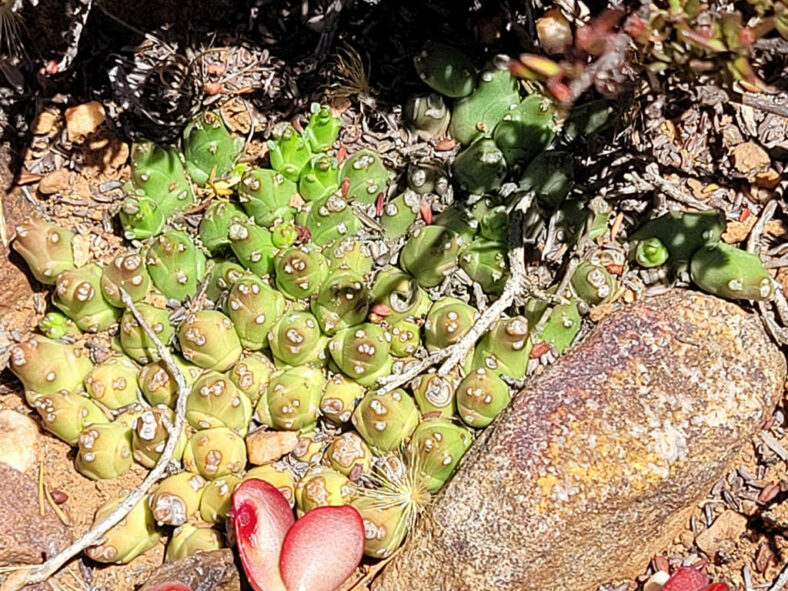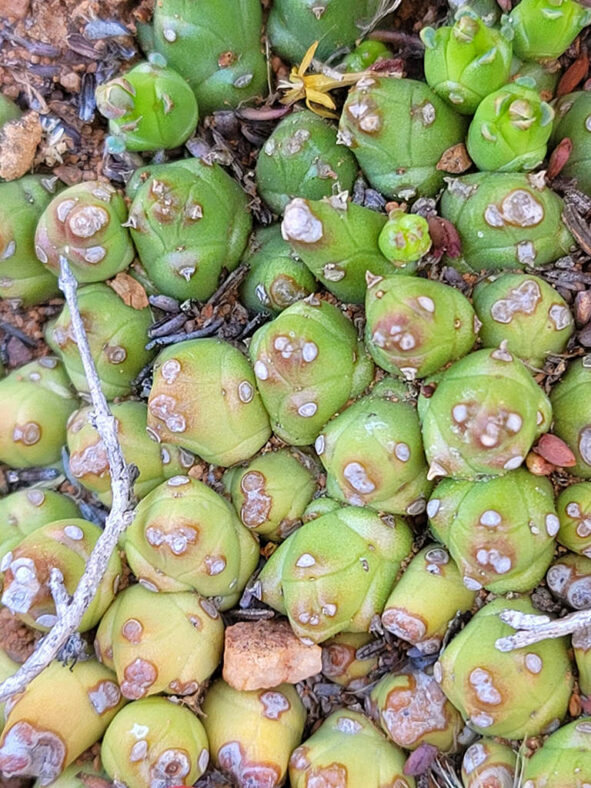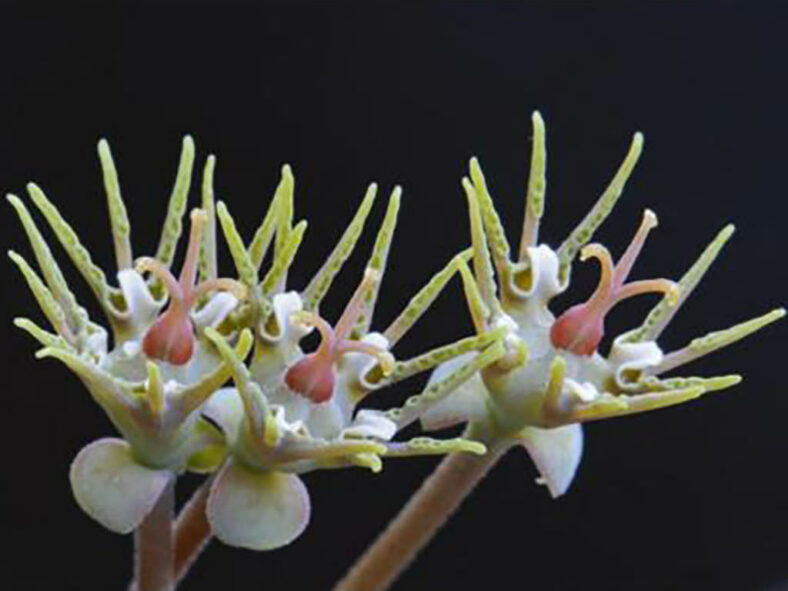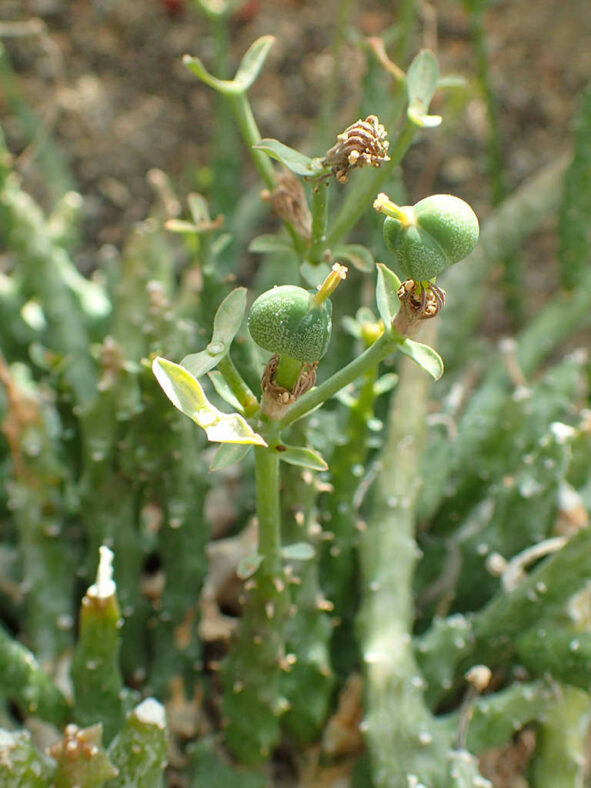Euphorbia patula has been divided into four subspecies: Euphorbia patula subsp. anacantha, Euphorbia patula subsp. brucebayeri, Euphorbia patula subsp. patula, and Euphorbia patula subsp. wilmaniae.
Scientific Name
Euphorbia patula Mill.
Common Name(s)
Bird's Foot Euphorbia
Synonym(s)
Dactylanthes patula, Medusea patula, Euphorbia patula subsp. patula
Scientific Classification
Family: Euphorbiaceae
Subfamily: Euphorbioideae
Tribe: Euphorbieae
Subtribe: Euphorbiinae
Genus: Euphorbia
Etymology
The specific epithet "patula" (pronounced "PAT-yoo-luh") means "wide open; spread out, extended" and probably refers to the growth habit of this species.
Origin
Euphorbia patula is native to South Africa. The subspecies Euphorbia patula subsp. patula grows in flat areas or gently rolling hills in several widely separated areas in slightly arid to semi-arid parts of the Cape Provinces.
Description
Euphorbia patula is a small succulent that forms a cluster of gray-green, often rhizomatous branches radiating from a central tuber. The branches are erect, spherical to cylindrical, usually tapering towards tips, and can grow up to 6 inches (15 cm) long and 0.5 inches (1.2 cm) in diameter. They are tuberculate and bear several small, narrow, deciduous leaves at their tips.
This plant usually blooms in spring but may continue throughout summer into fall. The branches taper into a short, slender peduncle with several leaf-like bracts below the terminal bisexual cyathium. The peduncles often branch from the axils of the uppermost bracts, producing 2 to 4 or more cyathia. The cyathium can reach a diameter of 0.7 inches (1.7 cm) and has prominent glands and a small central part with florets. The upper surface of the glands is green and heavily marked with cream or pale orange to yellow ridges. The glands have white inner margins recurved over the darker basal part of the gland, while the outer margins are divided into 2 to 5 spreading, finger-like processes.

How to Grow and Care for Euphorbia patula
Light: For optimal growth, Euphorbia spatula needs plenty of sunlight. Place it near a sunny window or move it to your balcony or garden during the warmer months, gradually increasing sun exposure to avoid sunburn.
Soil: Use a well-draining soil, either a commercial potting mix formulated for succulents or create your own well-draining soil.
Temperature: While high summer temperatures are not a problem, low winter temperatures can damage or kill your plant. Euphorbia patula grows best in USDA Plant Hardiness Zones 10a to 11b, with average minimum winter temperatures ranging from 30 to 50 °F (-1.1 to 10 °C).
Watering: From spring to fall, water the plant when the soil's top inch (2.5 cm) feels dry. Reduce watering in winter and give it just enough water to prevent wilting. In the warm season, evening is the best time of the day for watering.
Fertilizing: To ensure the potted plant receives sufficient nutrients, apply a balanced fertilizer in a 10-10-10 NPK formulation, diluted to 1/4 strength weekly during the growing season.
Repotting: Although your Euphorbia patula does not need to be repotted often, it will benefit from repotting when it outgrows its pot. Repotting is best done in early spring at the beginning of the growing season. Wear gloves, protective clothing, and appropriate eye protection when handling this plant.
Propagation: The easiest and quickest way to propagate this plant is by stem cuttings. Although it can be started from seeds, it can be difficult for them to germinate. Be sure to take cuttings only during the growing season; spring is the ideal time to sow seeds.
Learn more at How to Grow and Care for Euphorbia.
Toxicity of Euphorbia patula
Euphorbia patula produces a poisonous white milky sap that may cause burns or irritation if it comes into contact with the skin or eyes. Therefore, keeping this plant away from children and pets is best.
Links
- Back to genus Euphorbia
- Succupedia: Browse succulents by Scientific Name, Common Name, Genus, Family, USDA Hardiness Zone, Origin, or cacti by Genus
Photo Gallery
Click on a photo to see a larger version.


